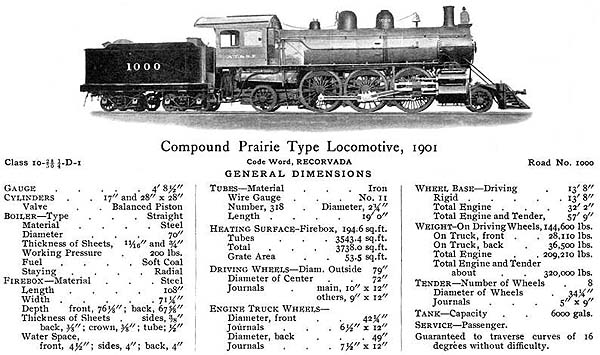|
The Scott Special On several occasions exceptionally rapid runs have been made over the Santa Fe System, the most recent being that of the Scott Special, which left Los Angeles at 1 P.M. on July 9, 1905, and reached Dearborn Station, Chicago, at 11.54 A.M. on July 11, covering 2265 miles in 44 hours 54 minutes, actual time, including all delays. This represents an average speed of 50.4 miles per hour, and the feat stands without a parallel in the history of long distance running. For practically half the distance the run was made through mountainous country, adding enormously to the difficulties encountered. Too much credit cannot be given the management and all the employees concerned, for this remarkable performance. The run was made for the accommodation of Mr. Walter Scott, a wealthy mine owner from Death Valley, California. Mr. Scott first proposed the trip on Saturday, July 8, and 25 hours later the special left Los Angeles. The price paid for the run was $5500. The train was made up, of a baggage car, a diner, and a Pullman sleeper, together weighing 170 tons. Nineteen locomotives were employed, manned by 18 engineers and 18 firemen. In addition, three helper engines were employed and an extra engine hauled the train for a short distance, owing to an accident to the regular train engine. The train was in charge of ten conductors, and the running was supervised by the various superintendents over whose divisions it passed. Of the 19 locomotives, 17 were Baldwin engines. One was a ten wheeler, four were of the Prairie type, with Vauclain compound cylinders, three were of the Pacific type, and nine were of the Atlantic type, with balanced compound cylinders. The latter class handled the train between La junta and Chicago, where the fastest time was made. The remaining two engines were Rhode Island ten-wheelers, similar to the Baldwin engine of the same type. In addition to these engines, a Baldwin compound Prairie type locomotive, with sixty-nine inch wheels, hauled the train from Kent to Newton, a distance of twenty-six miles, on account of the accident to the train engine referred to above. The following summary gives a general outline of the trip, showing the distance run by each locomotive, average speed maintained and other items of interest. Los Angeles to Barstow. - Engine 442, Baldwin ten-wheeler (type illustrated below), Engineer John Finlay. Distance, 141.1 miles. Time 2 hours 55 minutes. Delayed near Upland 3 minutes, hot tender journal; San Bernardino 6 minutes, water; Cajon 4 minutes, water. Helper engine, San Bernardino to Summit, 25.5 miles Maximum grade, 116 feet per mile. Average speed, including Stops, 48.5 miles per hour.
Barstow to Needles. - Engine 1005, Baldwin compound Prairie type (illustrated below). Engineer T. U. Gallagher. Distance, 169.3 miles. Time, 3 hours 19 minutes. Average speed, 51 miles per hour. Average ascending grade, Amboy to Goffs Summit, 52.4 miles, 37.6 feet per mile. Maximum grade, 53 feet per mile.
Needles to Seligman. - Engine 1010, Baldwin compound Prairie type. Engineer F. W. Jackson. Distance, 148.9 miles. Time, 3 hours 31 minutes. Average speed, 42.4 miles per hour. Average ascending grade for entire distance, 31.9 feet per mile. Maximum, 95 feet per mile. Seligman to Williams. - Engine 1016, Baldwin compound Prairie type. Engineer C. Woods. Distance, 50.8 miles. Time, 1 hour 29 minutes. Average speed, 34.4 miles per hour. Grades generally ascending. Maximum, 137 feet per mile. |









